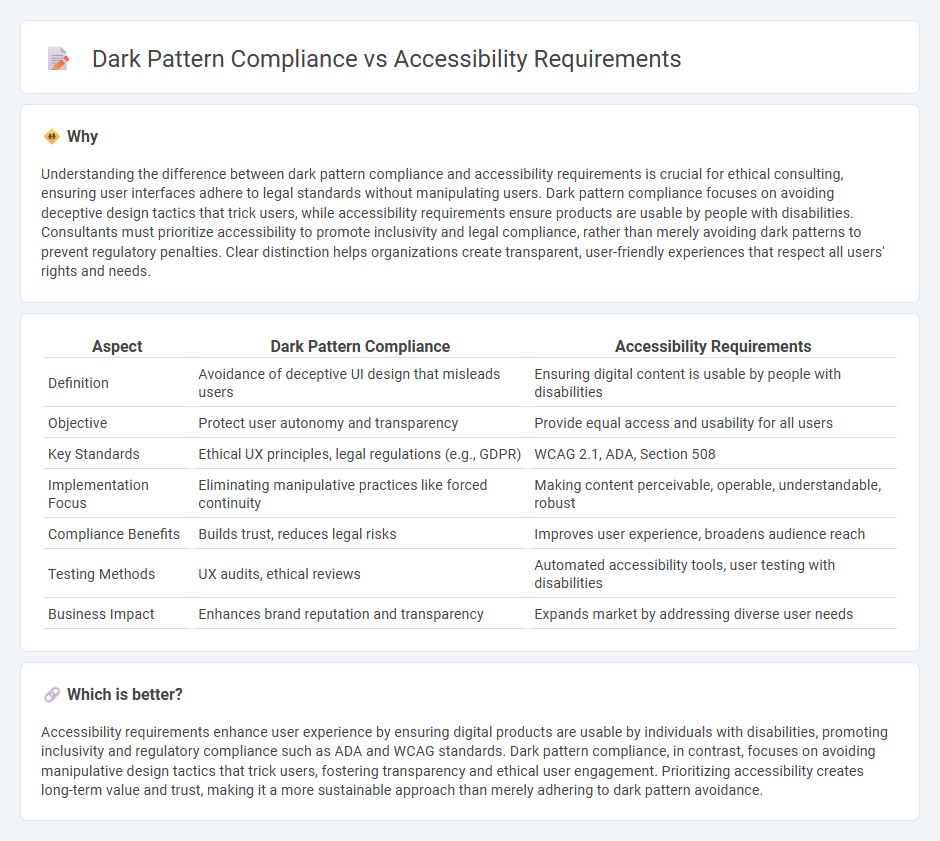
Consulting services navigate the complex intersection between dark pattern compliance and accessibility requirements, ensuring digital interfaces are both transparent and user-friendly while adhering to legal standards such as the ADA and GDPR. Experts identify and eliminate deceptive design practices that exploit user behavior, promoting equal access for individuals with disabilities through WCAG guidelines. Explore how professional consulting can help your organization balance ethical design with regulatory compliance.
Why it is important
Understanding the difference between dark pattern compliance and accessibility requirements is crucial for ethical consulting, ensuring user interfaces adhere to legal standards without manipulating users. Dark pattern compliance focuses on avoiding deceptive design tactics that trick users, while accessibility requirements ensure products are usable by people with disabilities. Consultants must prioritize accessibility to promote inclusivity and legal compliance, rather than merely avoiding dark patterns to prevent regulatory penalties. Clear distinction helps organizations create transparent, user-friendly experiences that respect all users' rights and needs.
Comparison Table
| Aspect | Dark Pattern Compliance | Accessibility Requirements |
|---|---|---|
| Definition | Avoidance of deceptive UI design that misleads users | Ensuring digital content is usable by people with disabilities |
| Objective | Protect user autonomy and transparency | Provide equal access and usability for all users |
| Key Standards | Ethical UX principles, legal regulations (e.g., GDPR) | WCAG 2.1, ADA, Section 508 |
| Implementation Focus | Eliminating manipulative practices like forced continuity | Making content perceivable, operable, understandable, robust |
| Compliance Benefits | Builds trust, reduces legal risks | Improves user experience, broadens audience reach |
| Testing Methods | UX audits, ethical reviews | Automated accessibility tools, user testing with disabilities |
| Business Impact | Enhances brand reputation and transparency | Expands market by addressing diverse user needs |
Which is better?
Accessibility requirements enhance user experience by ensuring digital products are usable by individuals with disabilities, promoting inclusivity and regulatory compliance such as ADA and WCAG standards. Dark pattern compliance, in contrast, focuses on avoiding manipulative design tactics that trick users, fostering transparency and ethical user engagement. Prioritizing accessibility creates long-term value and trust, making it a more sustainable approach than merely adhering to dark pattern avoidance.
Connection
Dark pattern compliance and accessibility requirements intersect by promoting ethical and user-friendly design practices that prevent manipulation and ensure equal access for all users. Adhering to accessibility standards, such as WCAG, inherently reduces the risk of using deceptive dark patterns by emphasizing transparency, clear navigation, and user control. Consulting services often focus on aligning dark pattern compliance with accessibility guidelines to enhance usability, trust, and regulatory adherence across digital platforms.
Key Terms
WCAG Guidelines
WCAG Guidelines are essential for ensuring digital accessibility by defining criteria for perceivable, operable, understandable, and robust web content, which directly contrasts with dark patterns designed to manipulate user behavior unethically. Accessibility requirements emphasize user empowerment and inclusivity, mandating features like keyboard navigation, screen reader compatibility, and clear content structure, while dark patterns often exploit cognitive biases, conflicting with the WCAG's intent. Explore detailed strategies to align your digital design with WCAG compliance and avoid unethical dark patterns for a more trustworthy user experience.
User Consent
User consent in digital interfaces must comply with accessibility requirements to ensure all users, including those with disabilities, can provide informed and voluntary agreements without confusion. Dark pattern compliance prohibits manipulative design tactics that obscure or coerce consent, maintaining transparency and user autonomy. Explore how balancing accessibility and ethical design enhances trust and legal adherence.
Deceptive Design Practices
Accessibility requirements ensure digital content is usable by people with disabilities, whereas dark pattern compliance pertains to avoiding manipulative design tactics that mislead users. Deceptive design practices, such as hidden costs or confusing opt-out options, directly conflict with ethical accessibility goals and transparency standards outlined in regulations like the ADA and GDPR. Explore more on how aligning design with both accessibility and anti-deceptive principles fosters user trust and inclusivity.
Source and External Links
ADA Standards for Accessible Design - The ADA sets physical accessibility requirements for buildings, including new construction, alterations, and barrier removal, to ensure access for people with disabilities, balancing accessibility with the size and resources of businesses.
ADA Accessibility Standards - Access-Board.gov - Provides detailed standards requiring accessible means of egress, priority for accessible elements during alterations, and rules against evading accessible path of travel by piecemeal alterations, emphasizing cost considerations.
ADA website Compliance Checklist & Guidelines for 2025 - Outlines key digital accessibility requirements for ADA compliance, such as keyboard navigation, alt text, video captions, color contrast, screen reader compatibility, and accessible forms for websites and mobile apps.
 dowidth.com
dowidth.com